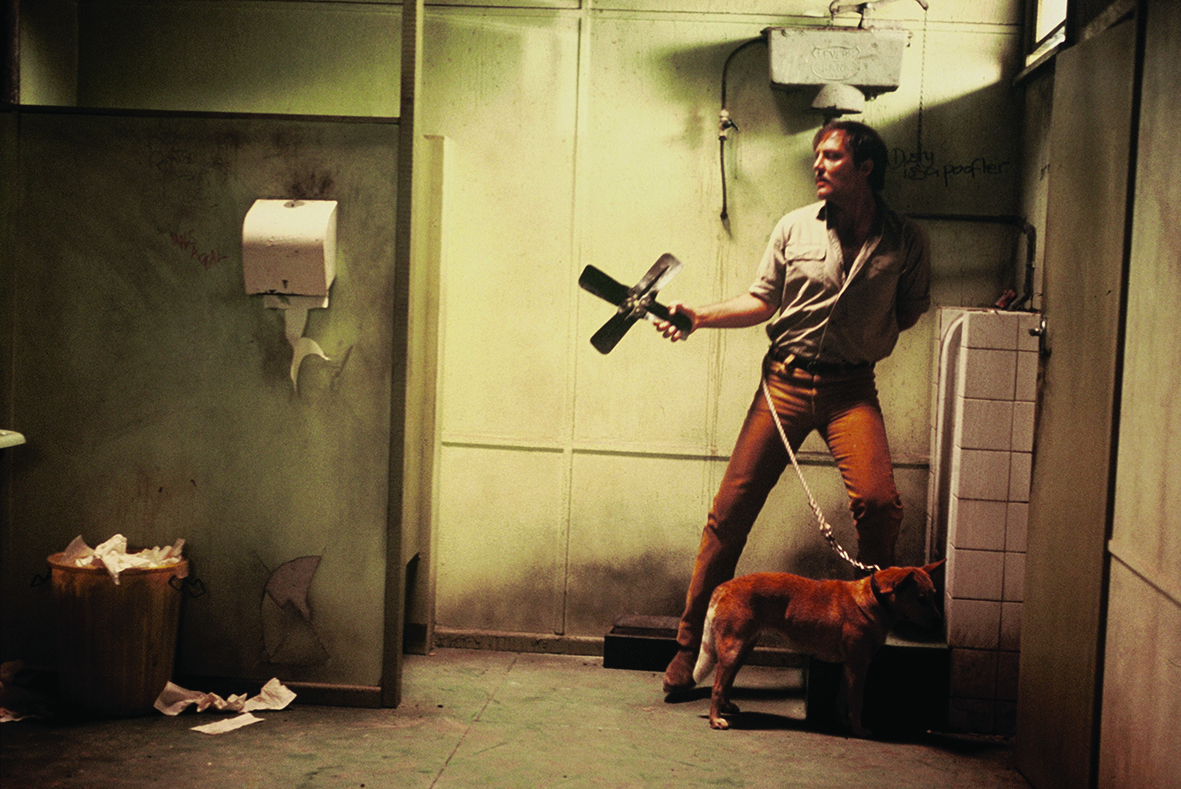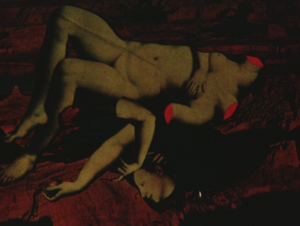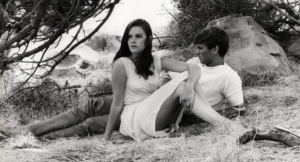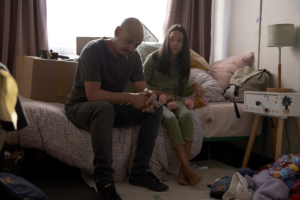The truck driver plays games … The hitchhiker plays games. And the killer is playing the deadliest game of all!
– US publicity poster for Roadgames
Significantly, Franklin, who has been shabbily treated by Australian reviewers, had to take his talents to Hollywood to find material that would adequately use his know-how in generating the melodramatic frisson.
– Brian McFarlane & Geoff Mayer[1]Brian McFarlane & Geoff Mayer, New Australian Cinema: Sources and Parallels in American and British Film,Cambridge University Press, Cambridge, UK, 1992, p. 137.
On 29 April 1980, Alfred Hitchcock died at his home in Los Angeles.[2]See Todd McCarthy, ‘Alfred Hitchcock Dies of Natural Causes at Bel-Air Home’, Variety, 30 April 1980, <https://variety.com/1980/film/news/alfred-hitchcock-dies-of-natural-causes-at-bel-air-home-1201344342/>, accessed 25 November 2022. One of his greatest admirers, the Australian director Richard Franklin, followed his passing with two homages. The first was an obituary published in Cinema Papers.[3]See Richard Franklin, ‘Hitchcock – A Personal Remembrance’, Cinema Papers, no. 27, June–July 1980, p. 165. The second, made over the course of the following year, was his big-screen tribute to the master of suspense: the thriller Roadgames (1981).
This enterprise did not go down well with those Australian critics who thought the film too beholden to Hollywood and not in the spirit of the cinema that had galvanised the national film industry from the mid 1970s onwards.[4]For further examples of the underestimation of Roadgames by Australian critics, McFarlane and Mayer refer to Albert Moran and Tom O’Regan’s The Australian Screen and Susan Dermody and Elizabeth Jacka’s Anatomy of a National Cinema, which respectively grumbles about the casting of two American actors in the leading roles and considers the film to have been ‘chilled’ by ‘commercial’ or ‘exploitationist motives’. See Moran & O’Regan (eds), The Australian Screen, Penguin Books, Ringwood, Vic., 1989, p. xiii; and Dermody & Jacka, Anatomy of a National Cinema, The Screening of Australia, vol. 2, Currency Press, Sydney, 1988, pp. 43–4 (both cited in McFarlane & Mayer, op. cit., p. 98). A later book, Jonathan Rayner’s Contemporary Australian Cinema, devotes less than a sentence to the film, dismissing it as a ‘commercially-oriented horror narrative’. See Rayner, Contemporary Australian Cinema: An Introduction, Manchester University Press, Manchester & New York, 2000, p. 149. These views contrast sharply with the opinion of director Quentin Tarantino, who declared in the Ozploitation cinema documentary Not Quite Hollywood (Mark Hartley, 2008) that Roadgames was his favourite Australian film. Movies like Peter Weir’s Picnic at Hanging Rock (1975), Fred Schepisi’s The Chant of Jimmie Blacksmith (1978), Phillip Noyce’s Newsfront (1978), Gillian Armstrong’s My Brilliant Career (1979) and Bruce Beresford’s Breaker Morant (1980) had elevated the status of Australian cinema at home and abroad, variously exploring Australian themes through period dramas interrogating the nation’s past, locally set coming-of-age narratives, realistic films based on Australian literary classics and so forth.[5]See Dermody & Jacka, ibid., pp. 33–4.
Franklin was not interested in making arthouse movies about Australia, however. His ideal, rather, was to make movies that would have a more universal appeal by touching on shared emotions like fear and guilt. He had seen Hitchcock’s Psycho (1960) at the age of twelve, and the film had left an indelible impression.[6]See Anton Bitel, ‘Discover This Newly Restored Hitchcock Aping Cult Horror’, Little White Lies, 1 February 2021, <https://lwlies.com/articles/link-1986-richard-franklin-hitchcock-horror/>, accessed 25 November 2022. To the disapproval of some Australian reviewers – who, in McFarlane’s estimation, ‘notoriously under-valued’ Franklin’s films[7]Brian McFarlane, Australian Cinema, 1970–1985, Secker & Warburg, London, 1987, p. 191. – the director was determined to make movies in the spirit of his Hollywood idol. All the Australian filmmakers mentioned above were to work in Hollywood over the next decade or so, but their calling cards remained their Australian successes. When Franklin moved to Hollywood in the 1980s, on the other hand, it was to make Psycho II (1983).[8]See Bitel, op. cit.
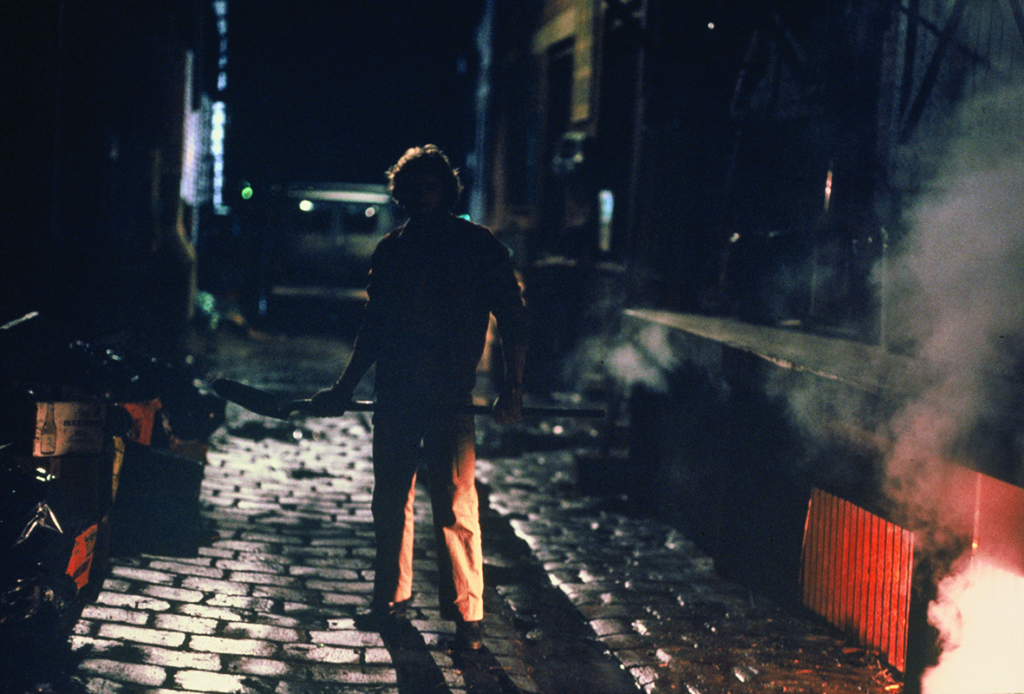
Wheels in motion
In a contemporaneous interview with Cinema Papers,[9]Scott Murray & Tom Ryan, ‘Richard Franklin: Director/Producer’, Cinema Papers, no. 28, August–September 1980, pp. 242–6, 299. as well as Perry Martin’s documentary short Kangaroo Hitchcock: The Making of Road Games (2003),[10]See featurette Kangaroo Hitchcock: The Making of Road Games, Roadgames DVD, Anchor Bay Entertainment, 2003, available at <https://vimeo.com/214607044>, accessed 6 December 2022. As is evident in this documentary’s subtitle, there is some inconsistency in promotional materials and coverage as to whether the title of Roadgames consists of one or two words; this article adheres to the style adopted by the film’s own credit sequence, in which the space is absent. Franklin has described Roadgames’ genesis and Hitchcockian derivations at length. As a film student at the University of Southern California (USC) in the late 1960s, Franklin once invited Hitchcock to participate in a post-screening discussion; to his amazement, he accepted. Franklin was subsequently invited to visit the set of the film Hitchcock was making at that time, Topaz (1969),and watch the master at work.[11]Franklin, ‘Hitchcock – A Personal Remembrance’, op. cit.
After returning to Australia in the early 1970s to launch his film career, Franklin began a long collaboration with Australia’s most prolific thriller screenwriter of the time, Everett De Roche; their first shared project was the hospital-set horror film Patrick (1978). Franklin recounts that, when he told De Roche that he would like his next feature to be a Hitchcock-style thriller along the lines of Rear Window (1954), the screenwriter suggested that, rather than having his hero housebound in a wheelchair like Jeff (James Stewart), it would be more interesting to have him constantly on the move.[12]Kangaroo Hitchcock: The Making of Road Games, op. cit. From this discussion emerged Roadgames’ protagonist, truck driver Pat Quid (Stacy Keach).
The film’s main part was originally written with Sean Connery in mind – less on account of his iconically charming James Bond role, one surmises, than the sardonic love interest he embodied in Hitchcock’s Marnie (1964). When it was discovered, however, that Connery’s fee would be the equivalent of the film’s entire budget (which was already high by Australian standards), they instead happily settled for US actor Keach.[13]ibid. This turned out to be a fortuitous choice: Keach not only adroitly captured the wry humour the role required, but his visible exhaustion – the actor had only just come from another film shoot – suited a character desperately short of sleep.
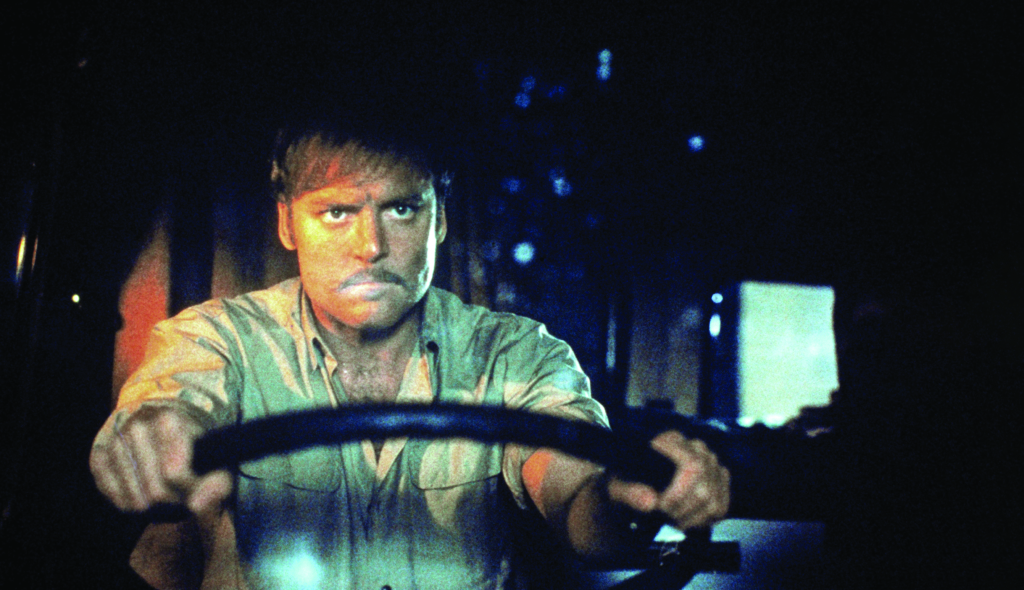
Although the fact that Franklin made his main character an American immigrant rather than Australian caused controversy, this choice was doubly important: as an outsider, Pat senses a strangeness about the country that a native might miss; and, conversely, he himself seems strange to the people he encounters. He quotes poetry, plays classical music on his radio and seems to see himself as an aristocrat at the wheel, telling one passenger, ‘Madam, just because I drive a truck does not make me a truck driver.’ It is vital to the film’s humour and suspense that Pat sometimes has difficulty in making himself understood on account of his accent. This is most notable in a scene in which he phones the police at a roadside cafe to alert them to a suspicious green van that might contain the serial killer they are seeking, yet, by the end of a long conversation, has still not even succeeded in communicating his name.
The casting of fellow American Jamie Lee Curtis as the film’s principal female character, ‘Hitch’,[14]Franklin sought and received permission from Hitchcock’s widow, Alma Reville, to give Curtis’ character this name as a tribute to his hero. See Murray & Ryan, op. cit., p. 245. was particularly unpopular with screen performer union Actors and Announcers’ Equity of Australia, and it was a choice that would go on to cause some friction during shooting.[15]ibid. Originally, Australian actress Lisa Peers had been selected for the role, but distributor Avco Embassy insisted on someone with ‘international standing’.[16]ibid. Curtis had recently starred in worldwide hit Halloween (1978), and it was that film’s director, John Carpenter – a former USC classmate of Franklin’s – who suggested her for the role in Roadgames. For Franklin, the opportunity to cast the daughter of Janet Leigh (so superb in Psycho, up to and including the most famous murder scene in Hitchcock’s – or, indeed, anyone’s – career) seemed too good an opportunity to miss.[17]Kangaroo Hitchcock: The Making of Road Games, op. cit.
Curtis and Keach make a likeable duo, their characters conveying a growing affection beneath their surface antagonism, but Franklin nonetheless copped flak from both sides: the production was not only censured for not casting an Australian, but the director later sometimes encountered criticism for not having given a box-office draw like Curtis a bigger part. In fact, that was never a possibility: by the time the role was cast, the part had already been written and they were ready to start filming.[18]ibid.
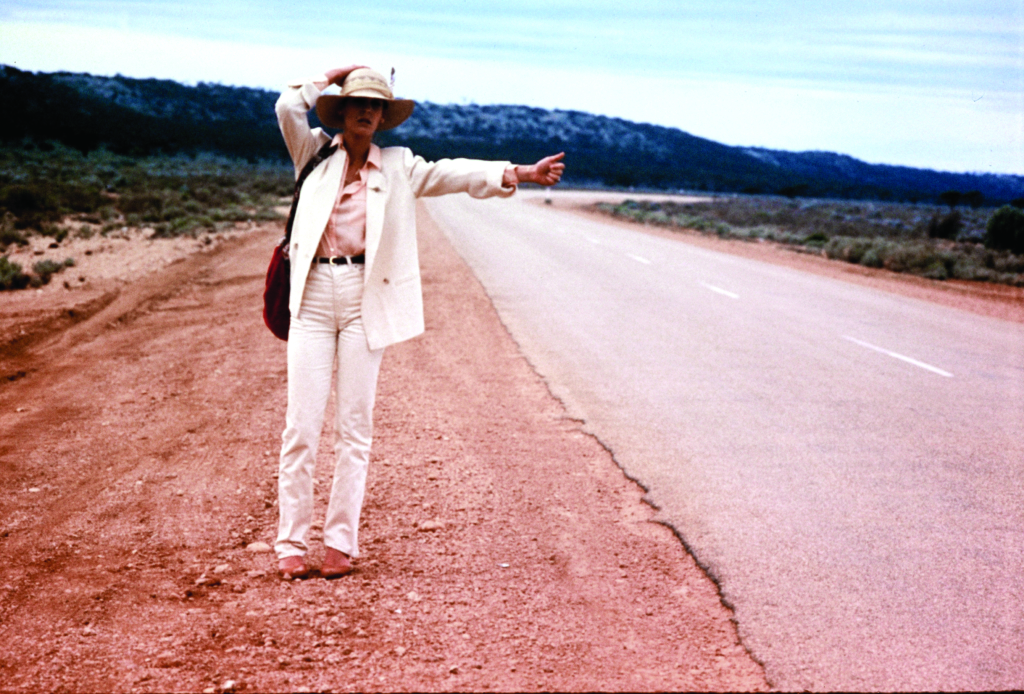
Rear-view mirror
Although inspired by Rear Window, Roadgames still works as an exhilarating thriller for anyone unfamiliar with its famous predecessor; while, for those who do know their Hitchcock, Franklin’s film also supplies inventive variations on the original. The basic situation is the same: the hero comes to believe that a person he is observing through his window (or, in this case, windscreen) has committed murder, and the narrative is henceforth driven by what he sees as confirmations of this suspicion. As in Rear Window, Roadgames is dominated by the hero’s point of view, which may not always be reliable: for instance, Pat repeatedly (and apparently erroneously) insists that his dog, Boswell, is a dingo. Some of the film’s quirky humour arises from similarly wayward perceptions on his part: for example, in a scene in which he believes he has cornered the killer, Pat launches a volley of abuse and threats to a man behind the locked door of a toilet, only to discover that the occupant lurking in terror is an entirely unconnected innocent.
The film shares further parallels with Hitchcock’s classic. Along the way, Pat acquires a female companion who, like Lisa (Grace Kelly) in Rear Window, eventually puts her own life in danger on account of a craving for excitement. And much as that film’s protagonist has a habit of compartmentalising the people he sees through his window (conferring nicknames such as ‘Miss Lonelyhearts’, ‘Miss Torso’ and ‘the newlyweds’), Pat does the same thing, labelling the people he sees prior to picking up ‘Hitch’ as ‘Fred and Frita Frugal’, ‘Captain Careful’, ‘Benny Balls’ and ‘Sneezy Rider’. All of these characters in Roadgames will have cause to resent Pat’s intrusion into their lives, and rear up accusingly at the end of the film like ghostly hallucinations of a guilty conscience.
Both Roadgames and Rear Window build towards a violent confrontation between the hero and the murderer, with the police – as is so often the case in Hitchcock’s films – arriving almost too late. Another commonplace Hitchcockian device Franklin uses is the double pursuit, in which the villain is being chased by the hero, who is in turn being tailed by police.[19]This plotline is present in, for instance, The 39 Steps (1935), Strangers on a Train (1951) and North by Northwest. In Roadgames, this frenzied chase ends in complete deadlock as all three vehicles become stuck in a narrow laneway. Pat is now trapped inside his truck, and, like Jeff in his wheelchair in Rear Window’s finale, is unable to move as the killer approaches. While Jeff has his photographer’s flashbulbs to keep the assailant at bay, Pat has his windscreen and truck headlights; but these are only fragile shields against the oncoming assault.
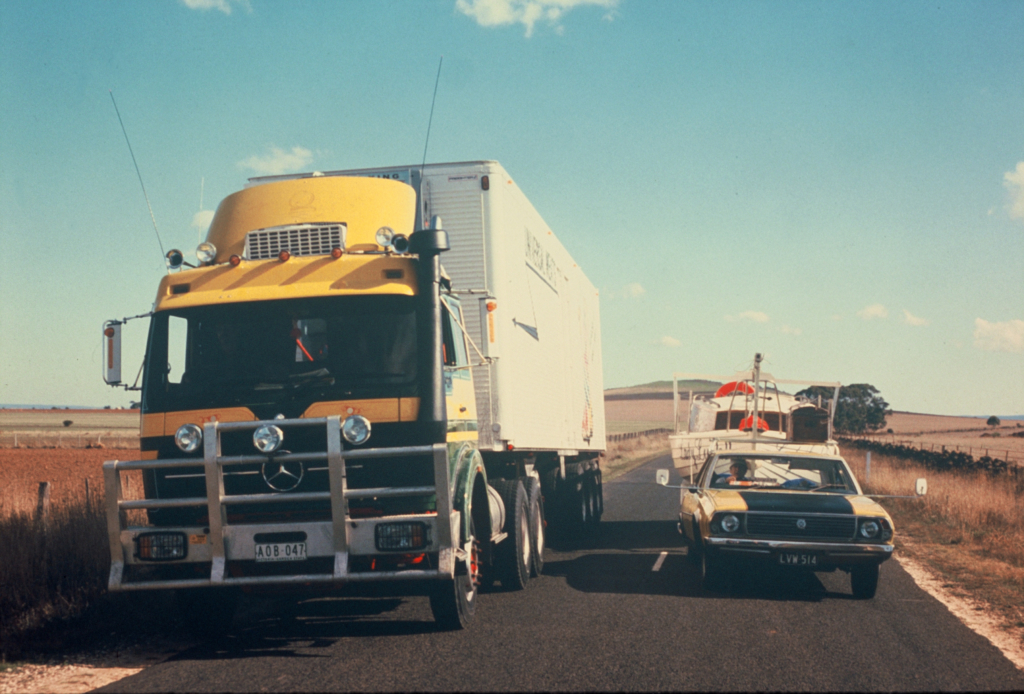
Fresh meat
In Kangaroo Hitchcock, Franklin describes Roadgames as ‘a soufflé […] full of air’ that ‘rises very nicely’ – in the vein, he suggests, of something like Hitchcock’s North by Northwest (1959).[20]Richard Franklin, quoted in Kangaroo Hitchcock: The Making of Road Games, op. cit. This seems apt up to a point, but there is still a fair amount of meat content in Roadgames. In this, the film at times recalls elements of late Hitchcock film Frenzy (1972): both have in common a gruesome murder, pervasive imagery of food and a tone that occasionally touches on the macabre. At one stage in Frenzy, the serial killer gets trapped in the back of a lorry with the body of the woman he has murdered and packed inside a sack of potatoes; while in Roadgames, Pat, who is transporting meat from Melbourne to Perth, begins to suspect he might unwittingly be carrying human remains among his animal carcasses. In that context, the punning slogan on his truck, ‘Pleased to Meat You!’, takes on slightly sinister implications. Likewise, when ‘Hitch’ writes on the back of Pat’s truck the phrase ‘Tomorrow’s Bacon’, it seems to anticipate an ending in which said bacon could contain more than the butcher ordered.
Despite this streak of morbidity, Roadgames was a difficult film to categorise, making it something of a hard sell. Part of its originality lies in the fact that it has elements of road movie, horror, suspense and even screwball comedy; but how do you convey all that to a prospective audience? At the end of the film, there is another nod – so to speak – to Rear Window when a severed head drops into a cleaner’s bucket (the off-screen disposal of the corpse’s head similarly proves a major headache for Hitchcock’s villain). The decision to depict this gruesome sequence was not Franklin’s, however; rather, it was one imposed by the distributor contrary to the wishes of the director, who felt that such a shock ending belonged to a different kind of film.
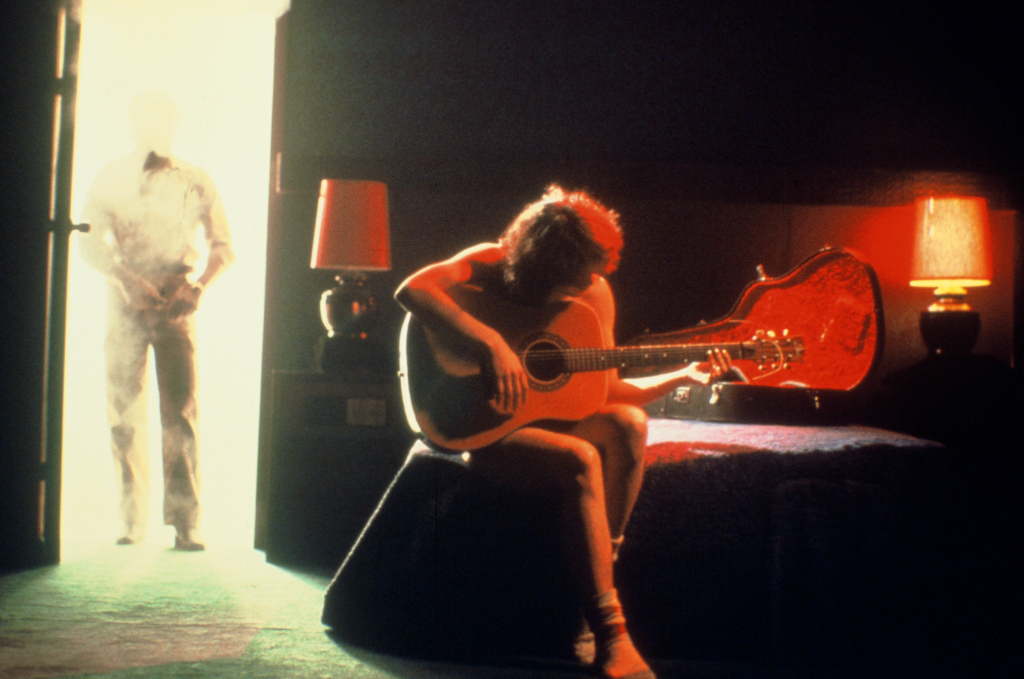
In fact, one could level a similar criticism at the murder in the pre-credits scene, which is arguably a miscalculation. While mindful of the fact that Hitchcock had not included the murder of Mrs Thorwald (Irene Winston) by her husband (Raymond Burr) in Rear Window –a decision he thought the master could get away with because of his reputation –Franklin felt he had to give the audience something to put them one step ahead of the central character. The depiction of the murder – a disturbing close-up of a nude young woman (Angie La Bozzetta) about to be throttled from behind with a guitar string – was contentiously made the focal point of the film’s promotion, with a stylised interpretation of the image not only appearing on the film’s main poster (and subsequently reproduced for the cover of several of the film’s DVD and Blu-ray releases) but also figuring prominently in the film’s misconceived trailer, where the impression given is one of a slasher horror movie. There is nary a hint of Roadgames’ lightness, wit or vitality of character in this publicity material. The film’s frisson of foreboding is far better implied by a single line – which has something of the sly suggestiveness of North by Northwest’s‘That plane’s dustin’ crops where there ain’t no crops’ – in which Pat asks himself, ‘Why does anybody get up at five o’clock in the morning to watch the garbage collectors?’
Boswell knows the answer to that question. One of Franklin’s most delightful variations on Rear Window is his use of Pat’s ‘dingo’: initially, the director recounts, this inclusion was simply to give the truck driver someone to talk to, but the protagonist’s canine companion becomes increasingly important as the film progresses. In Hitchcock’s film, a dog plays an important role when it is poisoned in suspicious circumstances after sniffing around the Thorwalds’ flowerbed. ‘Why would Thorwald want to kill a little dog?’ muses Lisa. ‘Because it knew too much?’ While there is a happier outcome for Boswell, he too will play a crucial role in unmasking a murderer. ‘What’s the matter, buddy?’ Pat asks at one stage. ‘You know something I don’t?’ Indeed, Boswell invariably knows something that Pat doesn’t; from the moment when he starts sniffing at a suspicious-looking rubbish bag in the film’s pre-credits sequence, he is always one step ahead of his master.[21]The dog’s name is a lovely touch: assuredly a reference to James Boswell, who served as biographer to eighteenth-century lexicographer Samuel Johnson. One can deduce this name has been bestowed by Pat, who is often given to showing off his literary knowledge and presumably sees his relationship with his pet as being akin to that between Johnson and his amanuensis, tasked with taking note of each pearl of wisdom dropping from his friend’s lips. For more on the real-life Boswell and Johnson, see Robert McCrum, ‘100 Best Nonfiction Books: No 77 – The Life of Samuel Johnson LLD by James Boswell (1791)’, The Guardian, 24 July 2017, <https://www.theguardian.com/books/2017/jul/24/100-greatest-non-fiction-books-all-time-a-life-of-samuel-johnson-james-boswell>, accessed 6 December 2022.
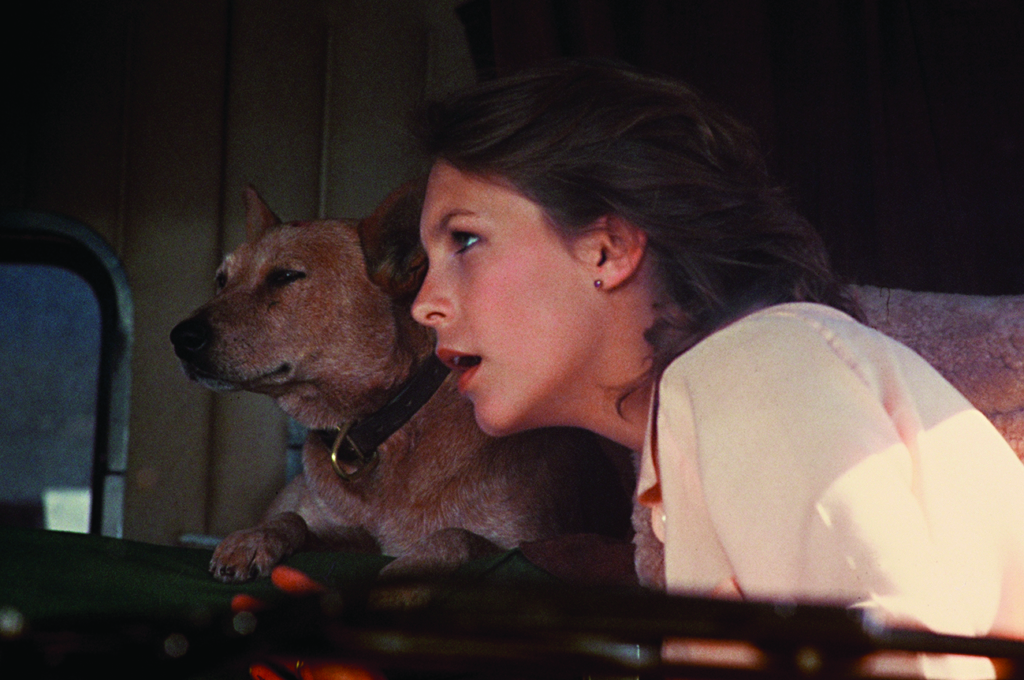
Reception and aftermath
Partly because of his dismay at Australian critics’ response to Roadgames, Franklin subsequently moved with his family to Los Angeles. His first Hollywood movie, Psycho II, was not a lazy sequel to an acknowledged classic, but rather – like Roadgames –a stimulating variation of, and development from, a Hitchcock original. He went on to direct a number of big-screen productions in the US – including an engaging children’s adventure film, Cloak & Dagger (1984) – but found Hollywood studio politics frustrating, and returned to Australia in the 1990s. There, Franklin made the relatively well-received drama Hotel Sorrento (1994), followed by a handful of other big- and small-screen productions, also finding work as a greatly valued teacher at Swinburne University of Technology before his death of cancer in 2007 at the age of fifty-eight.
Had Franklin been shabbily treated by local film reviewers? McFarlane, a long-time champion of his work, always thought so. As early as 1985 (by which time the director’s best work for the cinema was already behind him), the Australian film scholar was pondering why Franklin’s films were better appreciated abroad than in his native country: ‘Perhaps it is his unabashed commercialism; perhaps it is his failure to address Major Australian Themes; perhaps it is his sheer technical impudence.’[22]McFarlane, Australian Cinema, 1970–1985, op. cit., p. 191. Whatever the case, McFarlane concludes, Roadgames remains ‘one of the most exhilarating of all Australian films’.[23]ibid.
Part of Roadgames’ charm is the way it incorporates so much of the spirit of Australia – the sparky characterisation, the daunting landscape, the wildlife, a roadside cafe’s weird decor and even weirder personnel, the seriousness with which Australians play games – into its narrative, to the point where it is impossible to imagine the action taking place anywhere else. Ironically, the film’s impudent personality seems more Hitchcockian than Hitchcock’s own film set in Australia, Under Capricorn (1949), which delivers sombre melodrama rather than suspense.Like the best popular Hitchcock-influenced films, such as Charade (Stanley Donen, 1963), Obsession (Brian De Palma, 1976) or even High Anxiety (Mel Brooks, 1977), Roadgames has the flair and flavour of the master while retaining a personality of its own. Australian reviewers might have had their doubts, but Hitchcock surely would have loved it.
Endnotes
| 1 | Brian McFarlane & Geoff Mayer, New Australian Cinema: Sources and Parallels in American and British Film,Cambridge University Press, Cambridge, UK, 1992, p. 137. |
|---|---|
| 2 | See Todd McCarthy, ‘Alfred Hitchcock Dies of Natural Causes at Bel-Air Home’, Variety, 30 April 1980, <https://variety.com/1980/film/news/alfred-hitchcock-dies-of-natural-causes-at-bel-air-home-1201344342/>, accessed 25 November 2022. |
| 3 | See Richard Franklin, ‘Hitchcock – A Personal Remembrance’, Cinema Papers, no. 27, June–July 1980, p. 165. |
| 4 | For further examples of the underestimation of Roadgames by Australian critics, McFarlane and Mayer refer to Albert Moran and Tom O’Regan’s The Australian Screen and Susan Dermody and Elizabeth Jacka’s Anatomy of a National Cinema, which respectively grumbles about the casting of two American actors in the leading roles and considers the film to have been ‘chilled’ by ‘commercial’ or ‘exploitationist motives’. See Moran & O’Regan (eds), The Australian Screen, Penguin Books, Ringwood, Vic., 1989, p. xiii; and Dermody & Jacka, Anatomy of a National Cinema, The Screening of Australia, vol. 2, Currency Press, Sydney, 1988, pp. 43–4 (both cited in McFarlane & Mayer, op. cit., p. 98). A later book, Jonathan Rayner’s Contemporary Australian Cinema, devotes less than a sentence to the film, dismissing it as a ‘commercially-oriented horror narrative’. See Rayner, Contemporary Australian Cinema: An Introduction, Manchester University Press, Manchester & New York, 2000, p. 149. These views contrast sharply with the opinion of director Quentin Tarantino, who declared in the Ozploitation cinema documentary Not Quite Hollywood (Mark Hartley, 2008) that Roadgames was his favourite Australian film. |
| 5 | See Dermody & Jacka, ibid., pp. 33–4. |
| 6 | See Anton Bitel, ‘Discover This Newly Restored Hitchcock Aping Cult Horror’, Little White Lies, 1 February 2021, <https://lwlies.com/articles/link-1986-richard-franklin-hitchcock-horror/>, accessed 25 November 2022. |
| 7 | Brian McFarlane, Australian Cinema, 1970–1985, Secker & Warburg, London, 1987, p. 191. |
| 8 | See Bitel, op. cit. |
| 9 | Scott Murray & Tom Ryan, ‘Richard Franklin: Director/Producer’, Cinema Papers, no. 28, August–September 1980, pp. 242–6, 299. |
| 10 | See featurette Kangaroo Hitchcock: The Making of Road Games, Roadgames DVD, Anchor Bay Entertainment, 2003, available at <https://vimeo.com/214607044>, accessed 6 December 2022. As is evident in this documentary’s subtitle, there is some inconsistency in promotional materials and coverage as to whether the title of Roadgames consists of one or two words; this article adheres to the style adopted by the film’s own credit sequence, in which the space is absent. |
| 11 | Franklin, ‘Hitchcock – A Personal Remembrance’, op. cit. |
| 12 | Kangaroo Hitchcock: The Making of Road Games, op. cit. |
| 13 | ibid. |
| 14 | Franklin sought and received permission from Hitchcock’s widow, Alma Reville, to give Curtis’ character this name as a tribute to his hero. See Murray & Ryan, op. cit., p. 245. |
| 15 | ibid. |
| 16 | ibid. |
| 17 | Kangaroo Hitchcock: The Making of Road Games, op. cit. |
| 18 | ibid. |
| 19 | This plotline is present in, for instance, The 39 Steps (1935), Strangers on a Train (1951) and North by Northwest. |
| 20 | Richard Franklin, quoted in Kangaroo Hitchcock: The Making of Road Games, op. cit. |
| 21 | The dog’s name is a lovely touch: assuredly a reference to James Boswell, who served as biographer to eighteenth-century lexicographer Samuel Johnson. One can deduce this name has been bestowed by Pat, who is often given to showing off his literary knowledge and presumably sees his relationship with his pet as being akin to that between Johnson and his amanuensis, tasked with taking note of each pearl of wisdom dropping from his friend’s lips. For more on the real-life Boswell and Johnson, see Robert McCrum, ‘100 Best Nonfiction Books: No 77 – The Life of Samuel Johnson LLD by James Boswell (1791)’, The Guardian, 24 July 2017, <https://www.theguardian.com/books/2017/jul/24/100-greatest-non-fiction-books-all-time-a-life-of-samuel-johnson-james-boswell>, accessed 6 December 2022. |
| 22 | McFarlane, Australian Cinema, 1970–1985, op. cit., p. 191. |
| 23 | ibid. |
